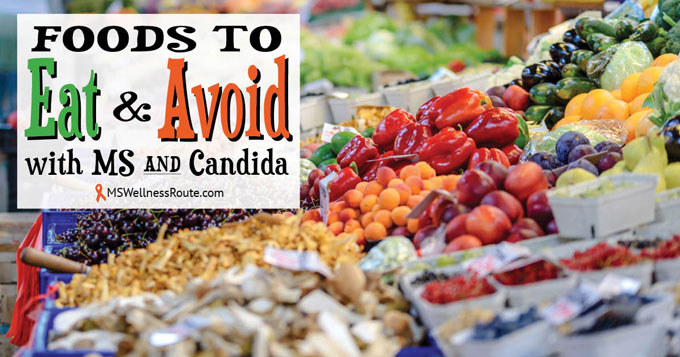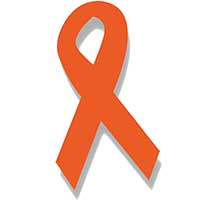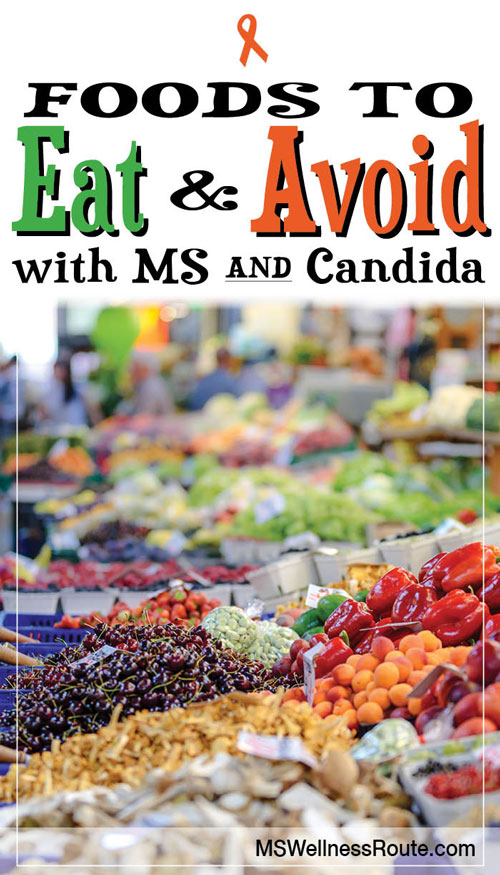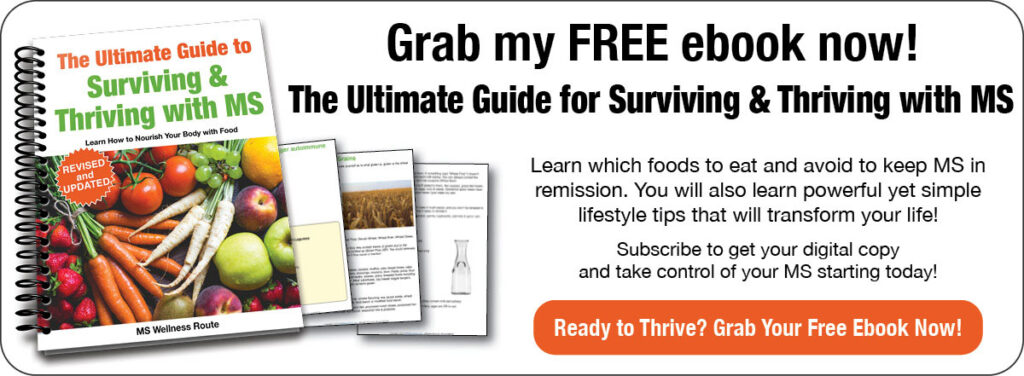Last Updated on December 5, 2023 by Cathy

I started using food as my medicine years ago and I’ve kept my multiple sclerosis (MS) in remission. There are many diets for MS so I’m often asked “Which diet are you on?” Throughout those years I’ve discovered the best foods to eat and avoid with MS. Now, I’d like to share that information with you.
I was on the Best Bet Diet (BBD) for many years but about eight years ago I had a huge setback due to daily chronic stress. So for the past five years, I’ve been on a Paleo diet, by now most people have heard of the Paleo diet. If not, it’s a diet that includes foods presumed to be part of our Paleolithic ancestor’s diet. People use this diet as an anti-inflammatory diet for autoimmune diseases such as MS.
There are many different versions of the Paleo diet depending on what your goal is. And, I’ve been on several different versions. Including the basic Paleo diet, an elimination diet (AIP), and the Wahls Protocol. I had been eating an anti-inflammatory diet for many years I didn’t see the results I was after. Which was reversing my old MS symptoms. It took me a few years but I finally figured out what works for me and my symptoms began to reverse!
Unfortunately, everyone is different so no “one” diet is going to work for everyone. But, I’d still like to share what worked for me because it may work for you too. First, I need to tell you a little history of what brought me to this discovery in case it fits your situation.
Possible Triggers for MS
There are many possible triggers to MS, it can even start in your genetic code. Researchers believe people with MS have a genetic disposition toward MS. Several years ago I had my DNA tested through 23andMe, it’s an easy process you spit into a tube and mail it in. You’ll receive it as raw data so you’ll have to go to a second party to read the results or see a genetic counselor. You can read about my experience including links to help you decipher your results, and DNA Test for Multiple Sclerosis.
No one in my family had MS and I didn’t expect anything about MS to show up. So I was very surprised to see I had a three times higher risk for MS. Obviously, it was an inherited gene. But researchers believe it’s not the gene that triggers MS, it’s the environment triggering MS.

Triggers to MS:
- Poor Diet
- Infections (bacteria, parasites, viruses, and yeast overgrowth)
- Environmental toxins (heavy metals, mold, pesticides, etc.)
- Chronic stress
- Hormones (adrenaline, cortisol, etc.)
Gut Health
Researchers have linked certain gut bacteria to MS. They’ve discovered higher levels of two different bacteria that cause inflammation. They also discovered lower levels of other bacteria that help fight inflammation. More studies are currently underway to see if probiotics may be a possible treatment.
Many factors can cause poor gut health. Problems begin when bad bacteria overgrow the good bacteria in your gut. Gut issues are more than just bloating. If left untreated it can lead to Candida, SIBO, and autoimmune diseases. So what causes poor gut health?
- Antibiotics
- Birth control pills
- Hormone imbalance
- NSAIDs (aspirin, Advil, ibuprofen, Motrin, etc.)
- Poor diet
- Slow digestion
- Steroids (corticosteroids, Prednisone, etc.)
- Stress
I started taking antibiotics as a toddler and continued to take them many times for years. I also ate the typical standard American diet. Which includes processed foods, refined sugar, and very few fruits and vegetables. All this leads to poor gut health and yeast overgrowth, also known as Candida. This is when the pieces began to fall into place for me, I was suffering from a severe overgrowth of Candida.
Symptoms of MS and Candida:
- Brain fog
- Chronic fatigue
- Depression
- Numbness
- Poor coordination
- Tingling
- Urinary frequency
Candida thrives in diets high in sugar, carbohydrates, processed foods, alcohol, and stress. Chronic stress not only brings on MS flares it also raises the hormone cortisol. Cortisol raises the blood sugar that Candida feeds on. Candida doesn’t care where the sugar comes from as long as it has something to feed on.
Quick Links to Information in this Post:
Candida Overgrowth
Candida is a yeast that lives in all of us. When antibiotics and other factors wipe out the good bacteria Candida moves. It begins to invade turning into a fungal form and attacking other organs. This fungus then goes wherever your body is most vulnerable (skin, nails, brain).
It not only grows but it can change making it a moving target for our immune system to fight. As a result, our immune system is always fighting Candida. This leads to major health issues such as MS. Maybe our bodies aren’t attacking our organs, maybe it’s attacking the Candida in our organs.
After researching I discovered a book called “Healing Multiple Sclerosis” by Ann Boroch. She also had MS and was able to get her disease to reverse by removing Candida overgrowth.
I bought the book, read it, and was ready to start. She also recommends many supplements and antifungals so it was going to cost quite a bit of money. I didn’t care, I was sick of living with numbness, tingling, heat intolerance, poor balance, and much more.
I did alter her diet a little because I wanted to stick to a strict Paleo diet. So I did a combination of everything I’ve learned and you should too. Don’t eat any foods you’re sensitive to and include as many vegetables as possible for the nutrients. I followed Dr. Wahls recommendation of eating nine cups of vegetables every day.
- 3 cups dark leafy greens
- 3 cups cruciferous (sulfur)
- 3 cups colored
Even though I’d been eating healthy for many years I was still learning which foods to eat and avoid with MS. Besides, foods that increase the good bacteria. Antifungal foods fight yeast overgrowth such as garlic and coconut oil. But there were other “healthy” foods such as fermented foods that can create problems.
Foods to Eat and Avoid with MS

I couldn’t wait to get started, hoping this book would help reverse my symptoms. The central nervous system is one of the slowest to heal. By eating quality foods and drinking clean water you can reverse the disease process. Foods high in omega-3 helps repair the myelin sheath and reduce inflammation. Foods that feed Candida are high in sugar, this includes fruits like oranges or bananas. Limit starchy vegetables because of their high carbohydrate (sugar) content. Since they’re high in nutrients eating them once or twice a week is fine.
Don’t look at this diet as a restriction, look at it as a way of rebuilding your body back to health. For some people this can go rather quickly, for others, it can take years depending on how severe or how long you’ve had MS.
Foods to avoid for the first three months:
There are additional foods to avoid for the first three months. This includes fermented foods. They can create more histamine in the body which is an allergy response. You want to avoid this at the beginning while your body is getting adjusted. Later you can add these back into your diet to help increase the good bacteria in your gut.
Kombucha is wild bacteria and yeast so it needs to be avoided longer depending on how your body reacts. I avoid it altogether because I want my body to heal quicker, the fewer irritants the less your body has to deal with. The only fermented food that’s allowed is apple cider vinegar. It helps the body get rid of Candida and it balances your pH level. For a full list of foods to eat and avoid check out the free checklist at the bottom of this post.
Prebiotics and Probiotics
Eating a diverse range of fruits, vegetables, herbs, and spices is beneficial for overall health and well-being. While fermented foods can contribute to a healthy gut microbiome by providing probiotics, which are beneficial bacteria, a balanced diet that includes a variety of plant-based foods offers numerous advantages for your health.
Here are some reasons why consuming fruits, vegetables, herbs, and spices is essential:
- Fruits and vegetables are rich in essential vitamins, minerals, antioxidants, and fiber.
- Fruits and vegetables are excellent sources of dietary fiber.
- Plant foods are packed with antioxidants, which help neutralize harmful free radicals in the body.
- Fruits, vegetables, herbs, and spices contain phytochemicals, which are natural compounds that have many health benefits.
- While fermented foods contribute probiotics to the gut, fruits and vegetables provide prebiotics, which are substances that nourish and support the growth of beneficial bacteria.
Take Care of Yourself
One major concern is getting your stress levels under control. As I mentioned earlier daily chronic stress was what set me back. You need to take care of yourself mentally and spiritually as well as physically. The good news about this diet, Candida isn’t the only thing you’ll be working on. You’ll also be treating bacteria, parasites, and some viruses. As you probably noticed, I don’t follow only one diet, I follow a combination of diets.
Embracing a diet focused on whole, nutrient-dense plant foods not only promotes better health for those with MS but also aligns with a holistic approach to overall well-being.
The best diet for MS isn’t one diet, it’s what works best for you.

Foods to Eat & Avoid on the Candida Diet
Subscribe for free and I’ll send you the password to my secret library filled with many printables including the Foods to Eat & Avoid on the Candida Diet for your wellness journey.
Want to remember this? Save this list of foods to eat and avoid for MS and Candida to your favorite Pinterest Board!







